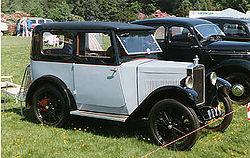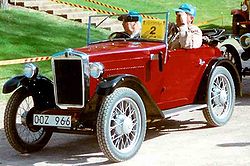- Morris Minor (1928)
-
Morris Minor 
Manufacturer Morris Motor Company Production 1928–1933
86,318Predecessor None Successor Morris Eight Class Small car Body style 4-door saloon
2-seat sports
4-seat tourer
Coupe
VanThis article refers to the motor car manufactured by the Morris Motor Company and its successors from 1928–1933. For the Morris Minor manufactured by the Morris Motor Company from 1948–1971, see Morris Minor.
The Morris Minor was produced by the Morris Motor Company in two versions. From 1928 to 1932 the cars had an 847 cc overhead-camshaft engine. This was replaced by a more conventional side-valve unit of the same capacity until production ended in 1934. 39,087 of the overhead-camshaft type and 47,231 of the side-valve version were made.[1]
The success of the Austin 7, launched in 1922, stimulated Austin's competitors to come up with rival designs. The Minor was Morris's attack on the small-car market that had really been created by the Seven.[2] Although the company's main assembly plant was at Cowley, outside Oxford, the chassis and running gear were designed at one of the company's subsidiaries, EG Wrigley, a Birmingham-based gearbox maker who had been bought out of receivership and renamed Morris Commercial Cars. The engine was based on one designed by Wolseley who were by then owned by William Morris personally. It was largely a new design, much smaller than any existing Wolseley unit, with the overhead camshaft driven by a geared shaft that passed through the dynamo carrying the armature. A single SU carburettor was fitted and coil ignition used. The engine produced 20 bhp (15 kW) at 4000 rpm[1] allowing a top speed of 55mph (88km/h). The electrical system was 6 volt.
The 78-inch (1981 mm) wheelbase chassis[3] was built of channel-section steel and the suspension was by half-elliptical springs all round with rigid front and rear axles. Brakes were on all wheels and cable operated. Initially the only body types offered were a 2-door fabric-bodied saloon and a four-seat tourer but during production up to a dozen different body styles were used. At the launch at London's 1928 Motor Show, the saloon cost £135 and the tourer £125. Steel-bodied cars and a van were added for 1930.
The engine was proving to be expensive to make and suffered from oil getting into the dynamo, therefore in 1931 a simplified side-valve version was designed giving nearly the same power output, 19 bhp (14 kW) at 4000 rpm. For a while both version were produced with the overhead-camshaft unit surviving until 1932 in the four-door model, which also gained hydraulic brakes.[1] The use of hydraulics distinguished the Minor from the competiting Austin 7 with its less reliable cable brakes. The lower cost of the new engine allowed the Minor to be sold for the magic £100 as a stripped-down two-seater.[2]
In 1932 the body was slightly restyled with a more rounded look and the fuel tank moved from the scuttle area below the windscreen to the rear of the car. An electric fuel pump was fitted. 1933 saw a four-speed gearbox replacing the three-speed unit on the more expensive models and in 1934 this was fitted with synchromesh on the top ratios. All models now had hydraulic brakes.
The Minor was replaced by the Morris Eight in 1934, which continued as a sales success and the Morris Minor name was revived in 1948 on the Issigonis-designed car.
References
Categories:- Morris vehicles
- Vehicles introduced in 1928
Wikimedia Foundation. 2010.


